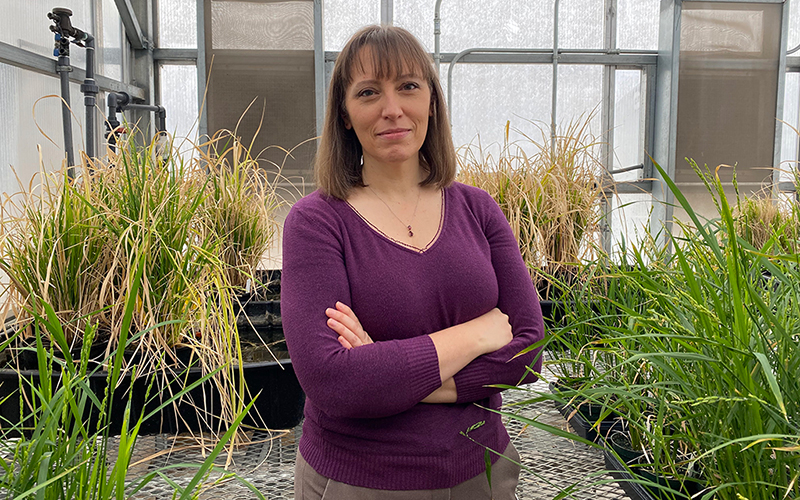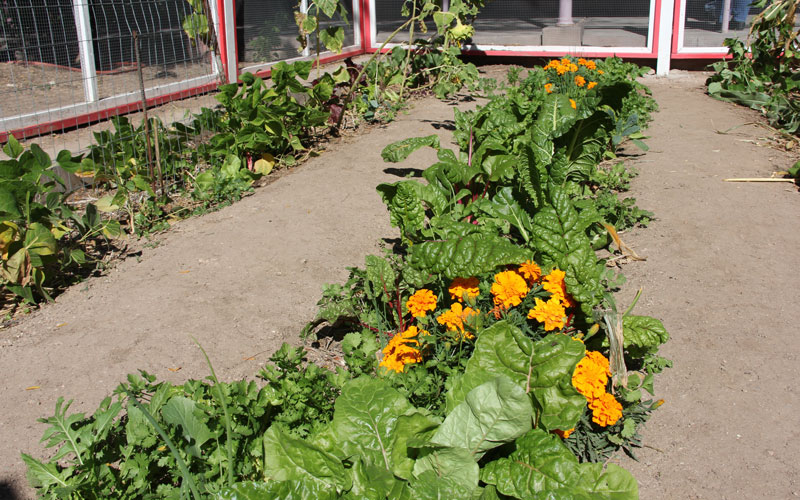TUCSON – The machine, with sharp teeth and a long metal rod, sounds like a kitchen blender, but this is far from your average appliance.
“This is a tissue homogenizer,” said Jesse Woodson, an associate professor at the University of Arizona’s School of Plant Sciences.
The “very fancy blender” is part of a project conducted by scientists at UArizona to understand how plants talk with each other. The ultimate goal is to engineer plants to help them survive a warmer world.
“We want to be able to establish communication with plants,” Woodson said. “And in order to do that, we need to know how plants are thinking about their environment and be able to sense their environment.”
Woodson and his team of students working in the lab are part of a much larger network of researchers. The National Science Foundation in October gave a $25 million grant to teams at UArizona, Cornell University and the Boyce Thompson Institute, both in New York, and the University of Illinois Urbana-Champaign to study plant communication in hopes of modifying plants for a future environment that’s likely to be warmer and drier.
Their research is part of the foundation’s new Center for Research on Programmable Plant Systems, or CROPPS. The scientists are working to better predict and manipulate agriculture at the molecular level to improve productivity and sustainability, according to the National Science Foundation. The transdisciplinary effort brings together scientists, engineers and computer scientists to create electronic systems that can monitor and control the responses of plants.
UArizona received $3.5 million to study plant genes and how they react biologically to their environment. The team will use data analytics, but as the project starts up, they want to understand the language of plants first.
Although their communication is not audible, plants send internal signals all the time.
“They might be sending those signals internally within the body of the plant to help the shoots understand what’s going on in the roots,” said Rebecca Mosher, the lead investigator on the CROPPS project for UArizona. “They might be sending those signals to microbes in the soil to try to recruit those microbes. And so we want to understand those signals so that we can maybe tap into them and communicate with the plants ourselves.”
These internal signals are similar to the signals our brains send us when we are stressed or in need of nutrition. However, Woodson said, plants lack one response that humans have. Plants can’t move.
“If we want to get away from something, we can run away. But a plant has to stay there and they have to deal with whatever happens,” he said. “So if it’s a hot day, it’s a dry day, there’s too much sun, if there’s not enough sun, the plant needs to do something about that in order to grow.”
When the plant is forced to grow in one spot, it creates a “survival guide” that it passes down to the next plant, which then learns how to conserve resources and adapt to its environment.
“You can’t always go by the looks or how big its brain is, but how much it can alter itself in order to fix the environment and with it in which it has to live,” Woodson said. “It’s going to have to deal with that at a very genetic level. So they need lots of genes and a lot of information stored in those cells to be able to grow and do well.”

Rebecca Mosher is the lead investigator for the UArizona team participating in a multi-university project funded by the National Science Foundation to understand how plants communicate with their environment. (Photo by Emma VandenEinde/Cronkite News)
Experimenting to understand
Before the plants —which include rice and soybeans —enter the lab, they grow in greenhouses on the roof of a parking garage south of the Tucson campus. In those greenhouses, the plants’ environment is altered.
“We might give it very high light or lots of heat, a whole variety of abiotic stresses,” Mosher said. “We can also infect it with pathogens, so a biotic stress. And then we’ll collect that tissue and take it into the laboratory.”
Inside the lab, the team extracts cells using different methods – from spinning plants in a centrifuge to jostling them in vials filled with beads. Then researchers look at cells under the microscope.
The tissue homogenizer – a rod with sharp teeth at the end – is one of the most important devices researchers use because it cuts through the tough plant tissue to get to a plant’s cells. Inside those cells are chloroplasts, which are responsible for sensing light in its environment and performing photosynthesis.
“A lot of what we’re trying to look at is how components within cells, how cells do photosynthesis and respond to the environment,” Woodson said. “This homogenizer is basically a very fancy blender that breaks open the cells so we can pull out those chloroplasts to do experiments in the lab.”
Cristian Salazar De Leon, one of the graduate students on Woodson’s team, said the chloroplasts can reveal a lot about how plants react in high heat situations.
“Most of us look into a pathway where chloroplasts do the photosynthesis in plant cells (and look at) how they’re recycled, how they’re damaged and how the plant deals with those damaged cells,” Salazar De Leon said.
From there, the scientists can find which genes are responsible for helping the plant grow in harsh environments, then cross-pollinate plants to respond similarly. Salazar De Leon is working to prove that removing a particular gene that encodes for a specific enzyme can kill a plant. He hopes to find those patterns in other plants as well.
“This is just like one piece of an entire biochemical pathway that allows plants to be able to respond to UV light stress,” he said.

Cristian Salazar De Leon cross-pollinates Arabidopsis plants under the microscope. The small flowering plants lack a gene that helps them live under high-stress conditions. (Photo by Emma VandenEinde/Cronkite News)
Arizona’s climate perfect for testing
Although the NSF-funded universities each have their own lab for testing, Arizona’s climate offers a unique environment for experimentation.
“Our environment is incredibly hot, incredibly arid, the world is going to be turning more and more like Arizona as the planet heats up,” Woodson said.
Last year was the sixth warmest on record, according to the National Oceanic and Atmospheric Association. And 2020 was even hotter – it was the second warmest year on record. Temperatures in December 2021 made it the fifth-warmest December in 142 years.
As temperatures increase because of human activity that contributes to global warming, these experiments with plants could help scientists better support plants and crops in the future that are more resilient to temperature changes.
“If we can understand how plants grow with limited water in really hot environments, perhaps we can create new breeds and varieties that would be able to grow better,” Woodson said.
The UArizona project is expected to last five years. More research, the scientists say, could unlock more about plants and how they are adapting to climate change.



